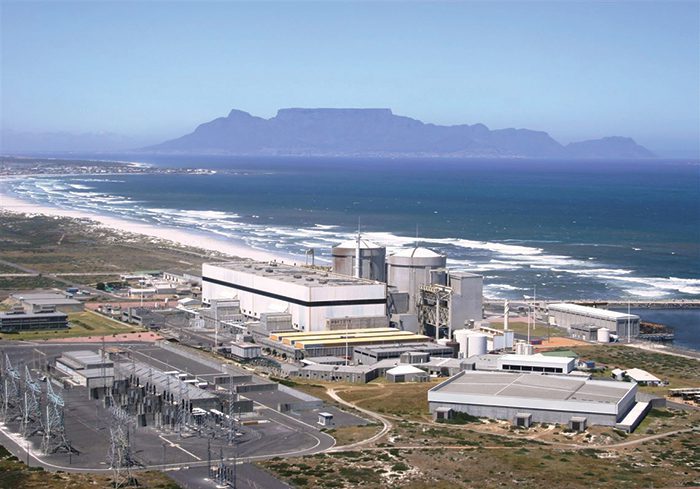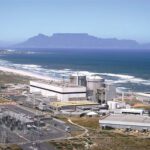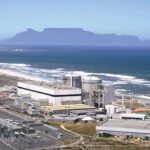South Africa’s longstanding ambitions to expand its nuclear power capacity gained some ground this July, after the nation’s nuclear regulator announced it would convene a public hearing relating to a nuclear installation site license (NISL) for one of two sites state-owned utility Eskom applied for in 2016.
The National Nuclear Regulator (NNR) said it would hold two days of public hearings starting on Aug. 25 on Eskom’s 2016 application to build and operate 3 GW to 4 GW of nuclear installations and associated auxiliary facilities and potentially expand them to 10 GW at the Thyspunt site, a coastal site in the Eastern Cape that faces the Indian Ocean.
Thyspunt, which sits west of Port Elizabeth (now officially renamed Gqeberha), and east of Oyster Bay, is currently characterized by “rocky promontories and headlands interspersed with sandy beaches,” Eskom said in its application. In 2016, Eskom also applied for similar nuclear installations at the Duynefontein site in the Western Cape, located just 2 kilometers (km) from the 1.8-GW Koeberg Power Station, Eskom’s sole existing nuclear plant at Melkbosstrand.
Koeberg, Africa’s Sole Nuclear Plant, Set for Long Term Operation
Grappling with crippling power shortages, owing to defective new plants and an unreliable aging fleet, among many other issues, Eskom currently relies heavily on Koeberg’s two pressurized water reactors (PWRs), which began operating in 1984 and 1985 (Figure 1). Set to play a pivotal role in South Africa’s future power plans, Eskom has embarked on a program to extend the Koeberg’s plant’s operating life by 20 years—to 2044 and 2045.
So far, the company says it has replaced several components, including the original low-pressure turbines for the plant generators, transformers, and refueling water storage tanks. It also plans to replace the plant’s six steam generators starting with Unit 2 in January 2022.
But while Eskom says the Koeberg Long Term Operation (LTO) project is “proceeding as per schedule,” it has run into hurdles. Unit 1, notably, suffered a forced outage in January owing to a steam generator tube leak. And in February, the NNR acknowledged “concrete cracking and delamination observed on the outer surface” of Koeberg’s containment buildings—though it ultimately determined that the containment structures “remain currently effective for protecting the environment from radiation during accident conditions.”
 |
|
A Long History of Planning for New Nuclear Plants
Eskom’s plans to build new nuclear plants, however, stem from a 2007 proposal that foresaw an imminent supply shortfall—which precipitated into its first debilitating load-shed event in 2008. (Load shedding is a “new normal” today, though Eskom executives have said the nation’s power situation is set to improve after September 2021.)
In a 2010 integrated resource plan (IRP), South Africa’s government envisioned six new 1.6-GW reactors that would come online starting in 2023, prompting a flurry of intergovernmental nuclear cooperation agreements and procurement determinations by South Africa’s government.
But following a 2017 high court invalidation of the 2010 nuclear new build program, the country in its 2019 IRP appeared to abandon a large nuclear expansion, calling instead for a life extension at Koeberg and a nuclear build program that the county “can afford,” including for small modular reactors (SMRs). In June 2020, the Department of Mineral Resources and Energy kicked off the process, requesting information related to a 2,500-MW nuclear build program.
Last October, prominently, the U.S. International Development Finance Corp. backed a 2,500 MW bid by NuScale for South Africa’s independent power producer program. The offer is significant because Eskom, beleaguered by its now decades-long reliability crisis, was saddled with $29 billion in debt as of March and maybe in no financial position to lead a large-scale expansion.
Keeping Nuclear on the Table
Still, the utility in April indicated it may be pushing for a new nuclear plant when it released a pointed response to an appeal that countered a 2017 finding from the Department of Environment, Forestry, and Fisheries (DEFF) that both Thyspunt and Duynefontein were environmentally viable. However, in that 2017 finding, DEFF favored Duynefontein, ultimately granting it an environmental authorization (EA) for the construction and operation of a nuclear power station (Nuclear-1). The agency said it preferred Duynefontein because it presented fewer ecological impacts than Thyspunt, a greenfield site. Because Duynefontein is adjacent to Koeberg, it could also harness “a suite of logistical and operational synergies,” DEFF said.
Thyspunt, meanwhile, already has confirmation from the South Africa Council for Geoscience that it is geologically and geotechnically suitable. But while the public hearings are a big step in the NNR internal licensing process, Thyspunt still needs a DEFF EA. For Eskom, both the Thyspunt and Duynefontein sites “remain viable nuclear sites for future electricity power generation,” hence the continuation with the NISL for both sites, it said in July.
According to a Public Information Document attached to the NNR’s July notice, Eskom said that while it has not decided on the specific design of reactors that could be installed at the proposed Thyspunt site, it is determined to go with PWR technology. “Eskom has been using this type of a reactor safely for over 35 years at Koeberg and is therefore familiar with this technology,” it said.
The utility also outlined “salient features” it would seek to procure in a new installation. These include a standardized design to expedite licensing, reduce capital costs, and reduce construction time, and a simple, robust design to make the plant easier to operate. Eskom also wants a high availability and a longer operating life—of more than 60 years—than current operating reactors, higher burn-up, and higher containment integrity. These features are characteristic of Generation III and III+ designs, including Westinghouse’s AP1000, South Korea’s APR1400, Framatome’s EPR, and Rosatom’s VVER1000, it said.
—Sonal Patel is a senior associate editor for POWER.









